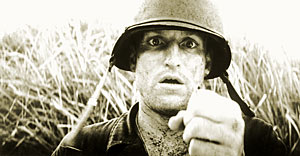While writer-director Terrence Malick's new film The Thin Red Line has haunting moments, the story he presents on the screen pales compared to the one of his own life. After having made two of the most memorable films of the 1970s (Badlands and Days of Heaven), Malick disappeared from filmmaking for 20 years. He returns with his most ambitious and frustrating movie to date.
Adapted from James Jones' dense, bitter novel, The Thin Red Line follows the cursed path of C-for-Charlie Company as they prepare to help take Guadalcanal from the Japanese during World War II. Its fall could end Tokyo's control of the Pacific.
Capturing the island is difficult. The terrain is steep and covered with jungle, and the enemy is well-hidden. Furthermore, the members of C-for-Charlie are not a harmonious unit. The commander, Col. Tall (Nick Nolte), is so determined to take the island that he disregards water shortages and severe casualties. His subordinate, Capt. Staros (Elias Koteas from Crash), clashes with him because he refuses to send his men to their deaths against a seemingly insurmountable foe. The battle eventually progresses in the Americans' favor, but the toll the conflict takes on the souls of the men makes victory or defeat irrelevant.
Malick keenly understands Jones' hatred of combat, and his oblique, mystical approach makes The Thin Red Line more than a "war is hell" movie. Despite the time that has passed, Malick has not lost his unique gift for images. With Badlands and Days of Heaven, he was able to bring out an exoticism to the American heartland. Imagine what this fellow can do with a Pacific location and Oscar-winning cinematographer John Toll (Legends of the Fall). In Malick's films, the elements are as much a part of the story as the characters. Through shifts in the sunlight or a gust of wind, he often conveys more than some filmmakers can do with pages of banter. In frame after frame, the director uses the camera and sounds in strange but powerful ways. The early battle scenes are especially frightening because the Japanese are, at that time, unseen.
Malick's flashes of brilliance make his stumbles seem more disheartening. Jones' story has a large cast of characters and Malick has difficulty focusing on them. Certain characters like Private Witt (John Caviezel) and Private Bell (Ben Chaplin from The Truth About Cats and Dogs) are indistinguishable at first. The problem is compounded because Malick overuses voice-over. Caviezel and Chaplin sound remarkably similar, so it's difficult to tell whose point of view is being expressed. The narration is needlessly florid and lamely states in words what he has already said eloquently with pictures. The movie also loses its drive during the final 45 minutes. The story slowly grinds to a halt.
The Thin Red Line misses its goal because Malick attempts too much with the film. Still, this ambition is a flaw more movies should have. (R) Rating: 6

Woody Harrelson grabs the wrong part of the grenade in The Thin Red Line.
© 1998 Fox 2000 Pictures, used by permission.

